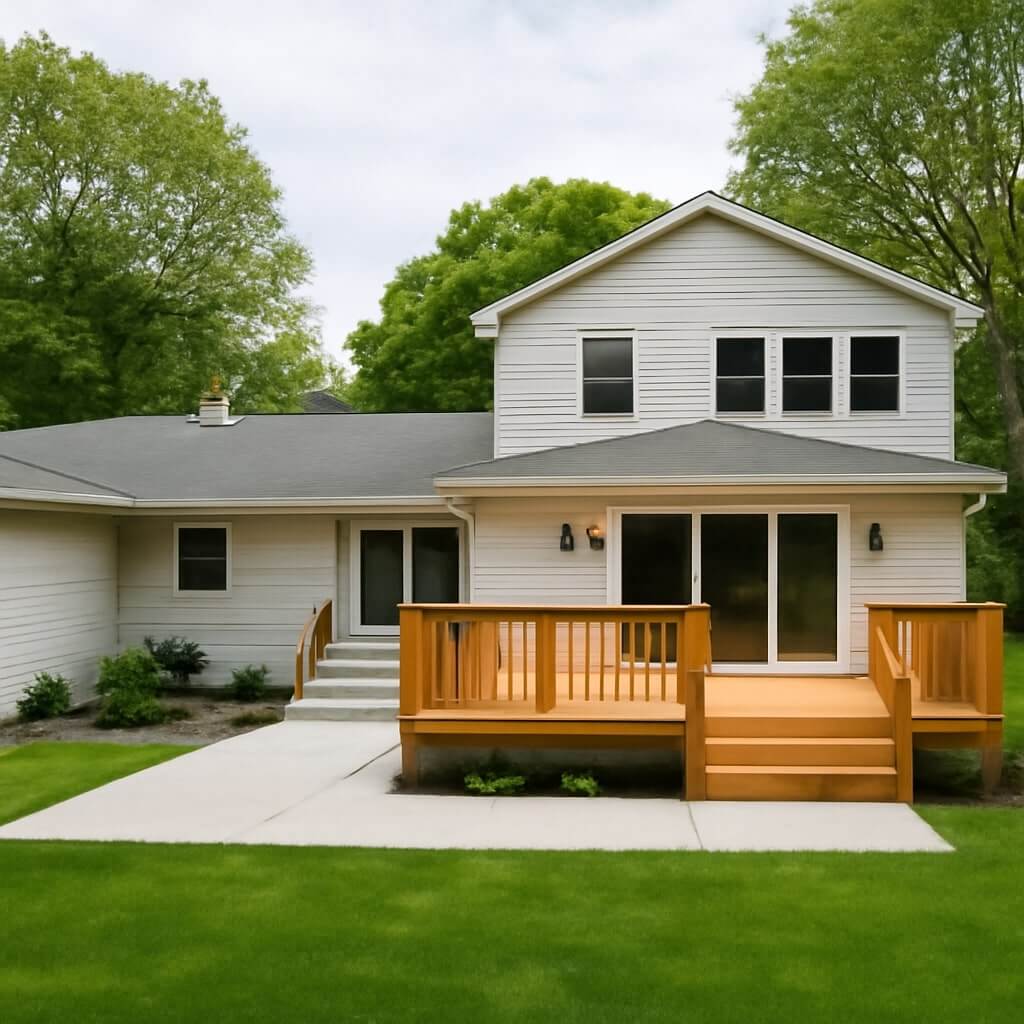When it comes to designing functional home additions for your ranch, it’s essential to start with a clear understanding of your needs and goals. Think about what spaces will enhance your lifestyle. Whether you need extra bedrooms or a larger living area, each decision will impact your home’s overall flow. As you explore options, consider how to make the addition blend seamlessly with your existing architecture, ensuring both functionality and aesthetic appeal. What comes next may surprise you.
Key Takeaways
- Assess your ranch’s current layout to identify areas for improvement and additional functional spaces such as bedrooms or hobby areas.
- Choose a location for your addition that complies with property boundaries and maximizes natural light through strategic window placement.
- Ensure the new addition uses similar materials and colors to maintain a cohesive architectural style throughout your ranch.
- Design for energy efficiency by incorporating quality insulation, ENERGY STAR appliances, and optimal window placements to reduce utility costs.
- Collaborate closely with architects and contractors to align on design goals, budget constraints, and project timelines for a successful addition.
Assessing Your Needs and Goals
When you consider a home addition, it’s essential to first assess your needs and goals, as this foundation will guide every decision you make.
Start by evaluating your lifestyle; are you frequently entertaining guests, or do you need a quiet workspace? Identifying priorities is vital—determine what functions are most important, like extra bedrooms or a larger kitchen.
Consider future possibilities, too; will your family grow, or might you want a dedicated hobby area?
This assessment not only clarifies your vision but also helps align your project with your budget, ensuring your home addition serves you well for years to come.
Choosing the Right Location for Your Addition
When choosing the right location for your home addition, it’s essential to assess property boundaries to guarantee compliance with local regulations.
Additionally, consider how you can maximize natural light in your new space, as this will enhance both functionality and ambiance.
Assessing Property Boundaries
Before diving into your home addition project, it’s essential to assess property boundaries to guarantee your plans comply with local regulations and avoid potential disputes.
Start by locating your property lines, which often require a survey for accuracy. Understanding these boundaries helps you determine the best placement for your addition, ensuring you’re within zoning regulations.
Familiarize yourself with setback requirements, which dictate how far your structure must sit from the property lines. This knowledge won’t only protect your investment but also maintain harmony with neighbors and local authorities, paving the way for a successful home expansion.
Maximizing Natural Light
To guarantee your home addition thrives with natural light, carefully consider its orientation and placement on your property. Position the addition to face south or west, maximizing sunlight exposure throughout the day.
Optimize window placements, ensuring larger windows capture the sun’s rays during peak hours. Incorporate skylight installations to draw in additional light, especially in areas where wall space is limited.
Think about overhangs and shading to control sunlight intensity during warmer months, preventing overheating. By thoughtfully designing your addition, you’ll create a bright, inviting space that complements your home while enhancing energy efficiency and ambiance.
Ensuring Seamless Integration With Existing Architecture
Integrating a home addition with your existing architecture requires careful planning and attention to detail, as mismatched styles can disrupt the overall harmony of your living space.
To achieve architectural harmony and design consistency, consider the following:
- Materials: Use similar exterior materials to create a cohesive look.
- Color Palette: Match the colors of your addition to the existing structure.
- Roofline: Maintain consistent rooflines to guarantee visual uniformity.
- Architectural Features: Incorporate design elements like windows and trim that echo your home’s style.
Maximizing Natural Light and Ventilation
How can you transform your home addition into a bright, airy sanctuary? Start by implementing effective natural light strategies, like large windows or skylights, to flood the space with sunlight.
Consider orienting your addition to capture ideal daylight, using overhangs to control heat gain.
For ventilation techniques, incorporate operable windows or sliding doors to encourage cross-breezes, enhancing airflow.
Strategically place vents or ceiling fans to maintain comfort.
Use light-colored walls and reflective surfaces to amplify brightness.
With these thoughtful design choices, your home addition won’t only feel spacious but also promote a healthier, more inviting atmosphere.
Selecting Functional and Stylish Materials
Once you’ve established a bright and airy space, the next step involves selecting materials that enhance both functionality and style.
Prioritize sustainable materials that not only benefit the environment but also provide durability.
Opt for modern finishes that elevate your design while ensuring ease of maintenance.
Consider these four key elements:
- Bamboo Flooring: Eco-friendly and resilient, perfect for high-traffic areas.
- Recycled Glass Countertops: Stylish and unique, offering a pop of color.
- Low-VOC Paints: Safe for indoor air quality, promoting a healthier environment.
- Metal Roofing: Long-lasting and energy-efficient, combining aesthetics with performance.
Designing for Energy Efficiency
While energy efficiency often takes a back seat in home design, prioritizing it can greatly reduce utility costs and enhance comfort.
Start by integrating solar panels into your roof design; they harness renewable energy, considerably lowering your electricity bills.
Choose energy-efficient appliances that carry the ENERGY STAR label; these devices consume less power and water while maintaining performance.
Insulation is essential—use high-quality materials to keep your home temperature regulated, reducing heating and cooling demands.
Strategically placed windows allow for natural light while minimizing heat loss.
Creating Flexible Spaces for Future Needs
Incorporating energy efficiency into your home not only enhances sustainability but also sets the stage for creating flexible spaces that adapt to your evolving needs.
To achieve this, consider the following:
Consider implementing flexible design strategies to create adaptable spaces that meet your changing lifestyle needs.
- Design multi-purpose rooms that can transform based on your current lifestyle—think home office by day, guest room by night.
- Utilize adaptable layouts that allow easy reconfiguration for different activities.
- Install sliding partitions to create versatile zones without significant renovations.
- Choose modular furniture that can be rearranged or repurposed as needed.
With these strategies, your home can effectively respond to future demands and preferences.
Enhancing Outdoor Connections
As you explore ways to enhance your home’s outdoor connections, consider how integrating seamless shifts between your indoor and outdoor spaces can elevate your living experience.
Design outdoor seating areas that invite relaxation and social gatherings, strategically placed near large windows or sliding doors.
Create garden pathways that guide you through lush landscapes, connecting your home to nature. Use materials that complement your home’s architecture for a cohesive look.
Incorporating lighting along these pathways will extend your outdoor enjoyment into the evening.
These thoughtful details not only improve functionality but also foster a harmonious relationship between your living spaces and the outdoors.
Working With Professionals for a Successful Project
When you’re planning a home addition, selecting the right architect is essential for translating your vision into a workable design.
Collaborating closely with contractors guarantees that your project runs smoothly and stays on schedule.
Establishing clear communication throughout the process will help you address any challenges that arise, leading to a successful outcome.
Choosing the Right Architect
How do you guarantee your home addition project is a success? Choosing the right architect is vital. They’ll help you merge architectural styles with the latest design trends, making certain your addition complements your ranch’s character.
Here’s how to select the right professional:
- Portfolio Review: Examine their previous projects for style compatibility.
- Client Testimonials: Seek feedback from past clients to gauge satisfaction.
- Design Philosophy: Discuss their approach to blending functionality and aesthetics.
- Budget Understanding: Confirm they can work within your financial constraints while achieving your vision.
With the right architect, your home addition will flourish.
Collaborating With Contractors
After selecting the right architect, the next pivotal step is collaborating with contractors to bring your vision to life.
Establishing a strong partnership with your contractor is essential for successful project collaboration. Share your design goals and listen to their expertise, as they can offer invaluable insights into materials, timelines, and costs.
Prioritize contractor communication to guarantee everyone’s on the same page, minimizing misunderstandings. Regular check-ins and progress updates will keep the project flowing smoothly.
Establishing Clear Communication
Establishing clear communication with your professionals is essential for steering your home addition project toward success.
By fostering an environment of open dialogue, you can guarantee that everyone is aligned with your vision.
Here are four key strategies to enhance communication:
- Set Clear Expectations: Define roles, timelines, and deliverables from the start.
- Encourage Effective Feedback: Create opportunities for team members to share insights and suggestions.
- Schedule Regular Check-Ins: Maintain momentum by discussing progress and addressing concerns consistently.
- Utilize Visual Aids: Share plans, sketches, or models to clarify ideas and minimize misunderstandings.
Conclusion
To summarize, designing a functional home addition for your ranch requires a careful blend of your needs, aesthetic, and the existing structure. By prioritizing natural light, energy efficiency, and flexible spaces, you’ll create an inviting environment that evolves with your lifestyle. Collaborating with skilled professionals guarantees your vision aligns with practical considerations, resulting in a seamless integration that enhances both functionality and beauty. With thoughtful planning, your ranch can become the perfect reflection of your family’s needs and aspirations.

